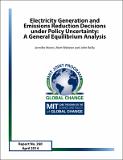| dc.contributor.author | Morris, J. | |
| dc.contributor.author | Webster, M. | |
| dc.contributor.author | Reilly, J. | |
| dc.date.accessioned | 2014-11-05T15:52:58Z | |
| dc.date.available | 2014-11-05T15:52:58Z | |
| dc.date.issued | 2014-04 | |
| dc.identifier.uri | http://hdl.handle.net/1721.1/91459 | |
| dc.description.abstract | The electric power sector, which accounts for approximately 40% of U.S. carbon dioxide emissions, will be a critical component of any policy the U.S. government pursues to confront climate change. In the context of uncertainty in future policy limiting emissions, society faces the following question: What should the electricity mix we build in the next decade look like? We can continue to focus on conventional generation or invest in low-carbon technologies. There is no obvious answer without explicitly considering the risks created by uncertainty. //
This research investigates socially optimal near-term electricity investment decisions under uncertainty in future policy. It employs a novel framework that models decision-making under uncertainty with learning in an economy-wide setting that can measure social welfare impacts. Specifically, a computable general equilibrium (CGE) model of the U.S. is formulated as a two-stage stochastic dynamic program focused on decisions in the electric power sector. //
In modeling decision-making under uncertainty, an optimal electricity investment hedging strategy is identified. Given the experimental design, the optimal hedging strategy reduces the expected policy costs by over 50% compared to a strategy derived using the expected value for the uncertain parameter; and by 12-400% compared to strategies developed under a perfect foresight or myopic framework. This research also shows that uncertainty has a cost, beyond the cost of meeting a policy. Results show that uncertainty about the future policy increases the expected cost of policy by over 45%. If political consensus can be reached and the climate science uncertainties resolved, setting clear, long-term policies can minimize expected policy costs. //
Ultimately, this work demonstrates that near-term investments in low-carbon technologies should be greater than what would be justified to meet near-term goals alone. Near-term low-carbon investments can lower the expected cost of future policy by developing a less carbon-intensive electricity mix, spreading the burden of emissions reductions over time, and helping to overcome technology expansion rate constraints—all of which provide future flexibility in meeting a policy. The additional near-term cost of low-carbon investments is justified by the future flexibility that such investments create. The value of this flexibility is only explicitly considered in the context of decision-making under uncertainty. | en_US |
| dc.description.sponsorship | The authors gratefully acknowledge the financial support for this work provided by the U.S. Department of Energy, Office of Science under grants DE-PS02-09ER09-26, DE-FG02-94ER61937, DE-FG02-08ER64597, DE-FG02-93ER61677, DE-SC0003906, DE-SC0007114, XEU-0-9920-01; the U.S. Environmental Protection Agency under grants XA-83240101, PI-83412601-0, RD-83427901-0, XA-83505101-0, XA-83600001-1, and subcontract UTA12-000624; and a consortium of government, industrial and foundation sponsors. | en_US |
| dc.language.iso | en_US | en_US |
| dc.publisher | MIT Joint Program on the Science and Policy of Global Change | en_US |
| dc.relation.ispartofseries | MIT Joint Program Report Series;260 | |
| dc.title | Electricity Generation and Emissions Reduction Decisions under Policy Uncertainty: A General Equilibrium Analysis | en_US |
| dc.type | Technical Report | en_US |
| dc.identifier.citation | Report 260 | en_US |
